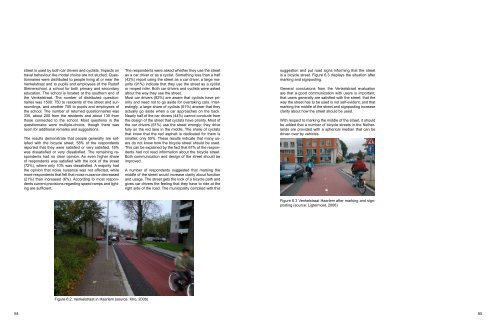Aalborg Universitet Bike Infrastructures Report Silva, Victor ... - VBN
Aalborg Universitet Bike Infrastructures Report Silva, Victor ... - VBN
Aalborg Universitet Bike Infrastructures Report Silva, Victor ... - VBN
You also want an ePaper? Increase the reach of your titles
YUMPU automatically turns print PDFs into web optimized ePapers that Google loves.
street is used by both car drivers and cyclists. Impacts on<br />
travel behaviour like modal choice are not studied. Questionnaires<br />
were distributed to people living at or near the<br />
Venkelstraat and to pupils and employees of the Rudolf<br />
Steinerschool, a school for both primary and secondary<br />
education. The school is located at the southern end of<br />
the Venkelstraat. The number of distributed questionnaires<br />
was 1500: 750 to residents of the street and surroundings,<br />
and another 750 to pupils and employees of<br />
the school. The number of returned questionnaires was<br />
335, about 200 from the residents and about 130 from<br />
those connected to the school. Most questions in the<br />
questionnaire were multiple-choice, though there was<br />
room for additional remarks and suggestions.<br />
The results demonstrate that people generally are satisfied<br />
with the bicycle street; 58% of the respondents<br />
reported that they were satisfied or very satisfied, 16%<br />
was dissatisfied or very dissatisfied. The remaining respondents<br />
had no clear opinion. An even higher share<br />
of respondents was satisfied with the look of the street<br />
(72%), where only 10% was dissatisfied. A majority had<br />
the opinion that noise nuisance was not affected, while<br />
more respondents that felt that noise nuisance decreased<br />
(21%) than increased (6%). According to most respondents<br />
current provisions regarding speed ramps and lighting<br />
are sufficient.<br />
The respondents were asked whether they use the street<br />
as a car driver or as a cyclist. Something less than a half<br />
(42%) report using the street as a car driver, a large majority<br />
(91%) indicate that they use the street as a cyclist<br />
or moped rider. Both car drivers and cyclists were asked<br />
about the way they use the street.<br />
Most car drivers (82%) are aware that cyclists have priority<br />
and need not to go aside for overtaking cars. Interestingly,<br />
a large share of cyclists (61%) answer that they<br />
actually go aside when a car approaches on the back.<br />
Nearly half of the car drivers (44%) cannot conclude from<br />
the design of the street that cyclists have priority. Most of<br />
the car drivers (61%) use the street wrongly: they drive<br />
fully on the red lane in the middle. The share of cyclists<br />
that know that the red asphalt is dedicated for them is<br />
smaller, only 55%. These results indicate that many users<br />
do not know how the bicycle street should be used.<br />
This can be explained by the fact that 67% of the respondents<br />
had not read information about the bicycle street.<br />
Both communication and design of the street should be<br />
improved.<br />
A number of respondents suggested that marking the<br />
middle of the street would increase clarity about function<br />
and usage. The street gets the look of a bicycle path and<br />
gives car drivers the feeling that they have to ride at the<br />
right side of the road. The municipality complied with this<br />
suggestion and put road signs informing that the street<br />
is a bicycle street. Figure 6.3 displays the situation after<br />
marking and signposting.<br />
General conclusions from the Venkelstraat evaluation<br />
are that a good communication with users is important;<br />
that users generally are satisfied with the street; that the<br />
way the street has to be used is not self-evident; and that<br />
marking the middle of the street and signposting increase<br />
clarity about how the street should be used.<br />
With respect to marking the middle of the street, it should<br />
be added that a number of bicycle streets in the Netherlands<br />
are provided with a spherical median that can be<br />
driven over by vehicles.<br />
Figure 6.3 Venkelstraat Haarlem after marking and signposting<br />
(source: Ligtermoet, 2006)<br />
Figure 6.2: Venkelstraat in Haarlem (source: Kho, 2006)<br />
64 65
















